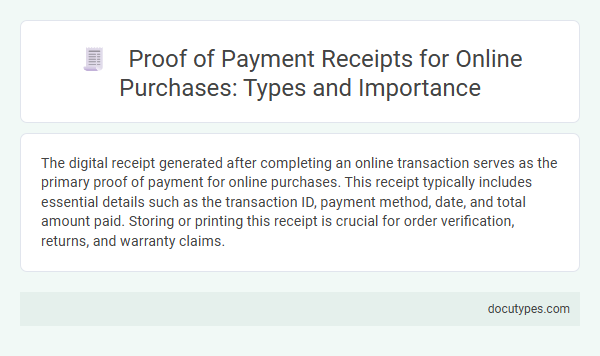The digital receipt generated after completing an online transaction serves as the primary proof of payment for online purchases. This receipt typically includes essential details such as the transaction ID, payment method, date, and total amount paid. Storing or printing this receipt is crucial for order verification, returns, and warranty claims.
Introduction to Proof of Payment Receipts
Receipts serve as crucial documents verifying your transactions, especially in online purchases. They provide evidence that payment has been successfully made to a seller or service provider.
Proof of payment receipts typically include details such as transaction ID, payment date, amount paid, and payment method. This information helps resolve disputes and confirms the legitimacy of your purchase.
Why Proof of Payment Receipts Matter in Online Shopping
In online shopping, the receipt used as proof of payment is typically an electronic receipt sent via email or accessible through the seller's website. This receipt contains essential transaction details such as the payment method, date, amount paid, and order number, confirming that the purchase was successfully completed. Proof of payment receipts matter because they serve as official documentation for tracking orders, resolving disputes, and managing personal finances securely.
Common Types of Proof of Payment for Online Purchases
| Receipt Type | Description | Purpose as Proof of Payment |
|---|---|---|
| Order Confirmation Email | Automatically sent by the online retailer after purchase completion. | Serves as initial proof of transaction and payment authorization. |
| Digital Payment Receipt | Generated by payment processors such as PayPal, Stripe, or credit card companies. | Verifies payment amount, date, and transaction ID, confirming payment completion. |
| Invoice | Provided by the seller detailing the purchased items and total cost. | Acts as an official document confirming sale and payment terms. |
| Bank or Credit Card Statement | Monthly statement from the financial institution showing the transaction. | Serves as third-party proof of payment when linked to the online purchase. |
| Mobile Payment App Receipt | Receipt generated by apps such as Apple Pay or Google Pay after transaction. | Confirms digital payment authorization and completion for online purchases. |
Emailed vs. Downloadable Receipts: Key Differences
Receipts serve as essential proof of payment for online purchases, helping verify transactions. Understanding the key differences between emailed and downloadable receipts ensures proper record-keeping and payment confirmation.
- Emailed receipts - Sent directly to a customer's inbox, providing immediate access and easy sharing for proof of purchase.
- Downloadable receipts - Available through a website or app portal, allowing users to save or print receipts at their convenience.
- Security and accessibility - Emailed receipts rely on email security, while downloadable receipts depend on account access and platform reliability.
Essential Information on an Online Purchase Receipt
An online purchase receipt serves as a crucial proof of payment for transactions made over the internet. This digital document confirms the transfer of funds from the buyer to the seller.
Essential information on an online purchase receipt includes the transaction date, total amount paid, and payment method used. It also contains details like the seller's name, item description, and order number. These elements ensure transparency and facilitate any future dispute resolution or returns.
Digital Receipts and Security Considerations
Digital receipts serve as the primary proof of payment for online purchases, offering instant and accessible confirmation of transactions. These electronic documents contain essential details such as transaction ID, payment method, and purchase date.
- Digital Receipt Format - Typically delivered via email or accessible through user accounts on merchant websites, ensuring easy retrieval and storage.
- Security Features - Digital receipts often include encrypted transaction data and unique identifiers to prevent fraud and unauthorized alterations.
- Record Keeping - Consumers and businesses rely on digital receipts for accurate record-keeping, warranty claims, and dispute resolution related to online purchases.
Secure management of digital receipts is crucial to maintaining privacy and verifying online payment authenticity.
The Role of Receipts in Processing Returns and Refunds
Receipts serve as essential proof of payment for online purchases, confirming that a transaction has been completed. Digital receipts typically include transaction details such as purchase date, amount, and payment method, which verify your payment.
Receipts play a crucial role in processing returns and refunds by providing evidence of the original purchase. Retailers require these receipts to authorize refunds or exchanges, ensuring a smooth and accurate resolution of your request.
Legal Importance of Proof of Payment Receipts
Which receipt is used as proof of payment for online purchases? An electronic receipt or digital invoice serves as the official document confirming your payment in online transactions. These receipts contain transaction details such as date, amount, and payment method, establishing their legal importance as evidence in case of disputes or refunds.
Best Practices for Storing and Managing Online Receipts
Receipts from online purchases serve as official proof of payment and confirmation of the transaction. Managing these digital receipts efficiently ensures easy access for returns, warranties, or tax purposes.
- Save receipts in a dedicated folder - Organize your online purchase receipts in a specific folder on your device or cloud storage for quick retrieval.
- Use receipt management apps - Employ apps designed to automatically capture and categorize digital receipts to streamline record-keeping.
- Backup receipts regularly - Create regular backups of your digital receipts to prevent loss due to device failure or accidental deletion.
Which Receipt Is Used as Proof of Payment for Online Purchases? Infographic

